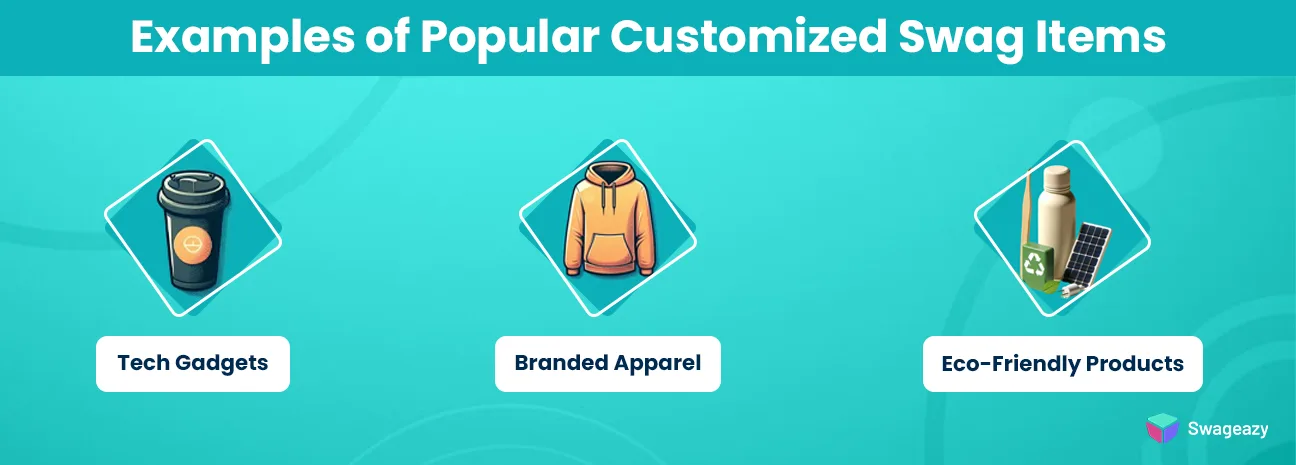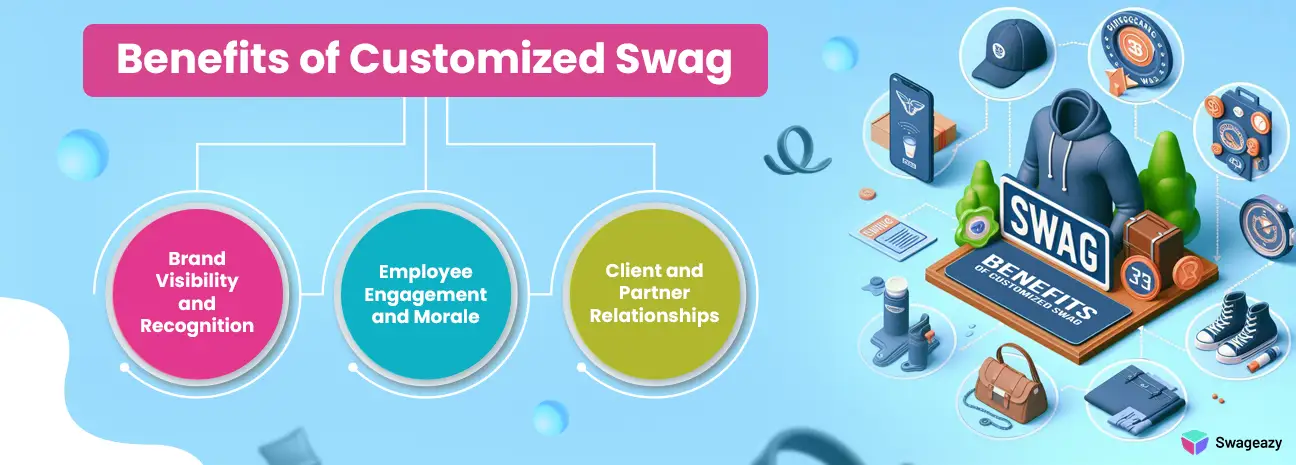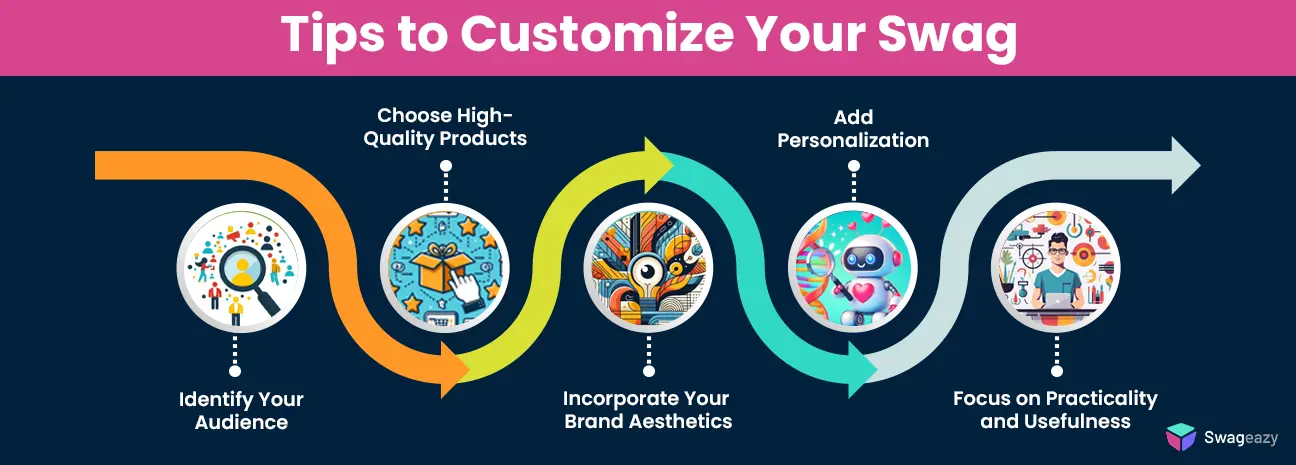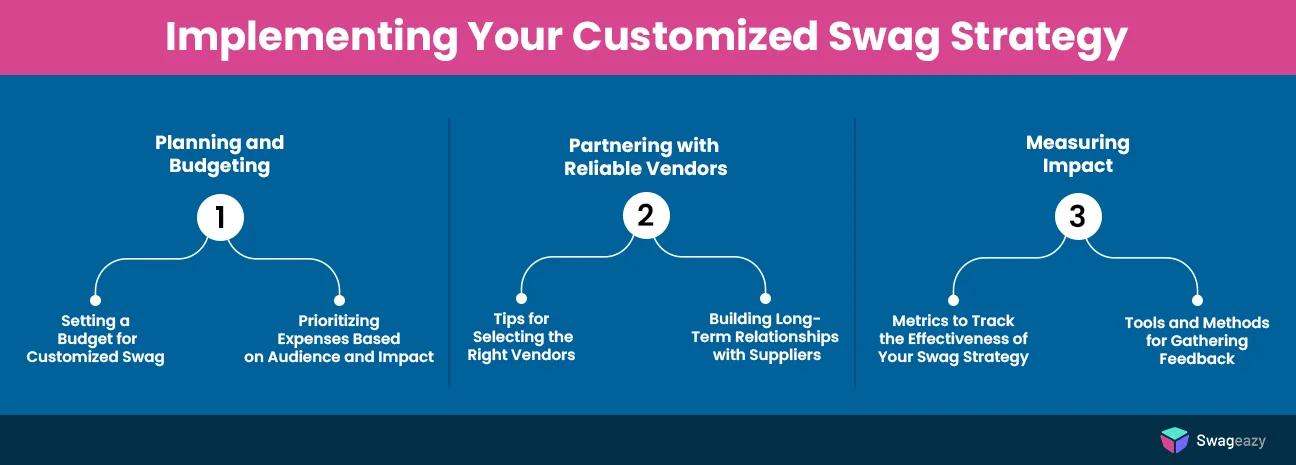
How to Customize Swag: A Guide
Brand visibility is a key factor in making one’s presence felt in the market, especially when you;re a startup.
Customized swag—personalized merchandise branded with your company's logo or message—has become an effective strategy to enhance brand visibility and create a lasting impression in the minds of partners, clients and employees.
In this guide, we will look at how you can ace swag customization ensuring it not only reflects your brand's identity but also resonates with your audience.
Whether you're planning corporate gifts, event giveaways, or employee appreciation items, this guide will help you navigate the world of customized swag with confidence.
Understanding Customized Swag
To effectively leverage customized swag in your marketing efforts, it's crucial to grasp what it is and how it differs from generic promotional items.
So let us look at the nitty gritties of customized swag.
Customized swag refers to branded merchandise tailored to reflect a company's identity, values, and messaging.
Unlike generic promotional items, customized swag is personalized with logos, slogans, or designs specific to a brand, making it a powerful tool for marketing and relationship-building.
The purpose of customized swag extends beyond mere advertising; it aims to create a tangible connection with recipients, enhancing brand recognition and loyalty.
Companies use customized swag for various purposes, including corporate gifting, event giveaways, employee appreciation, and customer engagement.
Differences Between Generic and Personalized Swag
The main distinction between generic and personalized swag is the degree of personalization. Generic swag usually consists of basic items that may not be customized or personalized, usually ending up not being memorable to the recipients.
On the other hand, personalized swag is created with certain brand features in mind and is, therefore, unique and easily recognizable.
This can range from the company’s logos and colors to specific messages or designs that are unique to a particular campaign or target group.
Thus, most often, the use of individualized items helps to strengthen the association with the brand and is more effective in terms of repeated recognition.
Examples of Popular Customized Swag Items

- Branded Apparel: Custom t-shirts, hats, and jackets featuring company logos or designs are popular choices, providing wearable branding that turns recipients into walking advertisements.
- Tech Gadgets: Items like branded USB drives, wireless chargers, and headphones are practical and often used daily, increasing the visibility and utility of the brand.
- Eco-Friendly Products: With growing environmental awareness, eco-friendly swag such as reusable water bottles, tote bags, and bamboo utensils are increasingly popular. These items not only promote the brand but also align with sustainable practices.
Benefits of Customized Swag
Customized swag offers numerous benefits for businesses looking to increase brand visibility, engage employees, and build strong client relationships.
Here are some of the key advantages of investing in customized promotional products:

Brand Visibility and Recognition
Customized swag is a powerful tool for increasing brand exposure and recognition. By placing your logo and branding on high-quality, useful products, you can ensure that your brand stays top-of-mind with your target audience.
One successful example of using customized swag to boost brand visibility is Coca-Cola's "Share a Coke" campaign.
By printing popular names on Coke bottles and cans, the company created a personalized experience that encouraged consumers to share photos on social media, dramatically increasing brand exposure.
The campaign resulted in an 11% increase in consumption among young adults and led to a significant rise in social media engagement.
Employee Engagement and Morale
Customized swag also contributes significantly to employee engagement and morale. Providing personalized gifts and apparel helps employers show their appreciation for their team and foster a sense of belonging and pride much better than other methods.
This commitment to employee engagement has helped Zappos maintain a positive company culture and low turnover rates.
Companies that implement employee swag programs often see increased job satisfaction and loyalty, which can lead to improved productivity and lower turnover costs.
Client and Partner Relationships
Customized swag can also be an effective tool for building and maintaining strong client and partner relationships. By sending personalized gifts and promotional items, businesses can show their appreciation and stay top-of-mind with their most valuable contacts.
According to a survey by the ASI, 83% of consumers said they were more likely to do business with the advertiser after receiving a promotional product.
Furthermore, 85% of consumers said they had a more favorable impression of the advertiser after receiving a promotional item.
Tips to Customize Your Swag
Creating effective customized swag involves thoughtful planning and a keen understanding of your audience.
Here are some essential tips to help you design swag that resonates and leaves a lasting impression.

Identify Your Audience
It is important to know your audience to choose the right swag to give out to your target audience.
Regardless of whether you are aiming at the employees, clients, or partners, it is crucial to understand what they will find useful and attractive.
Ensure that you have a package that is suitable for the target group of people you intend to give the swag to.
For example, the employees may like items that make their working environment more comfortable, like notebooks with the company logo or ergonomic products, while the clients and partners may like more posh gifts.
Choose High-Quality Products
The quality of your customized swag reflects directly on your brand. High-quality items not only last longer but also convey a message of value and professionalism.
Opt for products from reputable suppliers known for their quality and durability. Items like premium apparel, high-tech gadgets, and eco-friendly products are often well-received and can make a positive impression.
Incorporate Your Brand Aesthetics
Your swag should align with your brand's visual identity and overall aesthetic. This consistency helps reinforce brand recognition and ensures a cohesive look.
Use your brand colors, logos, and fonts consistently across all swag items. Consider creative design elements that stand out, such as unique patterns, innovative packaging, or interactive features.
Add Personalization
Personalizing swag adds a special touch that can significantly enhance its impact. It shows thoughtfulness and attention to detail, making the recipient feel valued.
Include names, roles, or special messages on items. For instance, personalized notebooks, custom-engraved pens, or even tailored apparel can make recipients feel uniquely appreciated.
Benefits of Personalization for Recipients: Personalization fosters a stronger emotional connection and makes the swag more memorable.
It also increases the likelihood of the swag being used and appreciated, further extending your brand's visibility.
Focus on Practicality and Usefulness
Choosing practical and useful items increases the likelihood that your swag will be used regularly, providing ongoing exposure for your brand.
Consider items that fit into daily routines, such as reusable water bottles, portable phone chargers, or high-quality tote bags. These items not only serve a functional purpose but also keep your brand in the recipient's mind.
Common Mistakes to Avoid
Creating customized swag can be an effective strategy for brand engagement, but it's important to avoid common pitfalls that can undermine your efforts.
Here are some mistakes to watch out for and how to prevent them.
Overlooking Audience Preferences
One of the most common mistakes is not thoroughly understanding your audience's preferences.
Customizing swag without considering what your audience values can lead to disengagement and wasted resources.
- Importance of Researching Audience Preferences: Conduct surveys, gather feedback, or analyze demographic data to understand what your audience appreciates. This research helps in choosing swag that resonates with them and increases the likelihood of the items being used and appreciated.
- Consequences of Misaligned Swag Choices: Swag that doesn't align with audience preferences can lead to negative perceptions of your brand. For example, giving away tech gadgets to a largely non-tech-savvy audience may result in the items being discarded or unused, reflecting poorly on your brand's understanding of its customers.
Compromising on Quality
Quality is a key factor in how your swag is perceived. Choosing low-quality products can have long-term negative impacts on your brand's image.
- Risks of Choosing Low-Quality Products: Low-quality items are more likely to break, wear out, or be discarded quickly, which diminishes their effectiveness as promotional tools. Poor quality can also suggest a lack of care or investment in your audience, which can harm your brand's reputation.
- Long-Term Impacts on Brand Perception: High-quality swag, on the other hand, reflects positively on your brand, suggesting that you value your customers and are willing to invest in quality. It's better to offer fewer, higher-quality items than to distribute a large number of inferior products.
Neglecting Personalization
Personalization can significantly enhance the appeal and effectiveness of swag, yet many companies overlook this opportunity.
- Missing Opportunities to Make Swag Special: Adding personal touches, such as names, custom messages, or unique designs, makes swag more memorable and meaningful to recipients. It also demonstrates that your brand values each individual, which can foster loyalty and positive associations.
- Examples of Ineffective Generic Swag: Generic swag items, like standard pens or keychains with just a logo, are often seen as less valuable or thoughtful. These items can end up forgotten or discarded, failing to provide the desired impact. Personalization, however, can transform even simple items into cherished gifts that enhance the recipient's connection to your brand.
Implementing Your Customized Swag Strategy
To maximize the benefits of customized swag, it's crucial to have a well-planned strategy that covers budgeting, vendor selection, and impact measurement.
Here's how to effectively implement your swag strategy.

Planning and Budgeting
Effective swag campaigns start with clear planning and budgeting. Determine how much you're willing to invest and prioritize your spending based on your audience's preferences and the potential impact of the swag items.
- Setting a Budget for Customized Swag: Allocate a budget that aligns with your overall marketing or employee engagement goals. Consider factors such as the size of your audience, the type of events where the swag will be distributed, and the desired quality of the items. This will help you make informed decisions on how much to spend on each item or campaign.
- Prioritizing Expenses Based on Audience and Impact: Focus your budget on items that offer the greatest value and impact for your target audience. For instance, investing in high-quality, practical items for a key client event may yield better results than spreading your budget thin across less impactful giveaways.
Partnering with Reliable Vendors
Choosing the right vendors is crucial for ensuring the quality and timely delivery of your swag. Establishing strong relationships with reliable suppliers can also lead to better deals and more customized options.
- Tips for Selecting the Right Vendors: Look for vendors with a proven track record in producing high-quality customized products. Check reviews, ask for samples, and consider their ability to meet deadlines. It's also beneficial to choose vendors who can offer a wide range of products and customization options to suit different campaigns.
- Building Long-Term Relationships with Suppliers: Developing a strong partnership with your vendors can lead to more consistent quality and potentially better pricing. Long-term relationships can also provide advantages such as priority service, more flexible terms, and early access to new products.
Measuring Impact
To gauge the success of your swag strategy, it's essential to track relevant metrics and gather feedback.
This helps in refining your approach and making data-driven decisions for future campaigns.
- Metrics to Track the Effectiveness of Your Swag Strategy: Key metrics include brand recall, customer engagement, and conversion rates. You can measure these through follow-up surveys, social media monitoring (e.g., mentions or shares of swag-related content), and tracking website traffic or sales linked to swag campaigns.
- Tools and Methods for Gathering Feedback: Utilize surveys, both online and at events, to gather direct feedback from recipients. Digital tools such as QR codes or unique tracking links on the swag items can also provide insights into how often and where the items are being used or mentioned online. This data helps you understand which items resonate most with your audience and why.
Summing Up
Customized swag is more than just a promotional tool; it's a strategic asset that can enhance brand visibility, foster employee engagement, and strengthen client relationships.
By carefully planning your swag strategy, choosing high-quality and personalized items, and measuring the impact, you can create meaningful connections with your audience and achieve long-lasting results.
Ready to Elevate Your Swag Game?
The most hassle-free way for you to access customized swag as a startup is to partner with Swageazy for your swag needs. Choose the swag you want from our exhaustive range of products that stretches from pocket-friendly options to luxury swag. Then, choose how to want it customized and leave everything, including shipping, to us.
Visit Swageazy today to learn more about our unique services, and why we’re the preferred swag partners of corporates around the country.